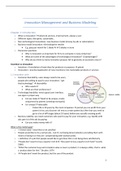Resume
Samenvatting innovation management and business modeling
- Établissement
- Universiteit Antwerpen (UA)
Dit is een samenvatting van het van innovation management and business modeling dat gegeven wordt door Wim Vanhaverbeke. Het is een openboek examen. Ik heb alle lessen bijgewoond, de cases samengevat en opgelost en alle slides samengevat.
[Montrer plus]



